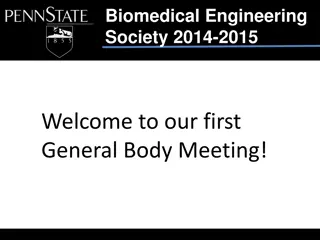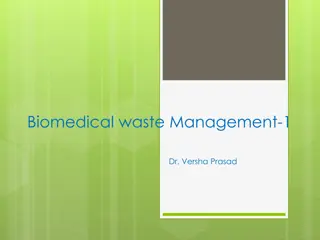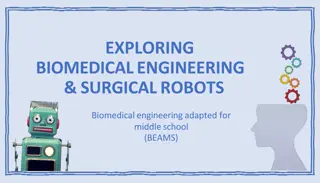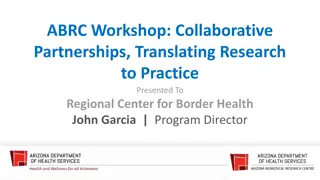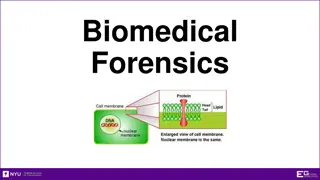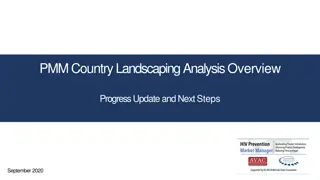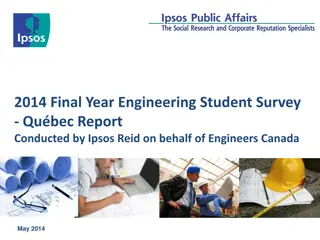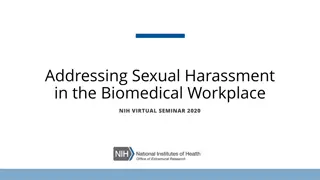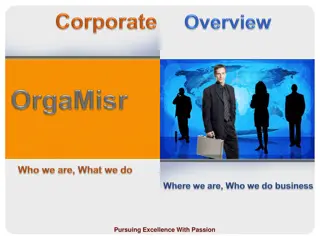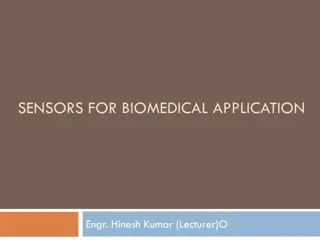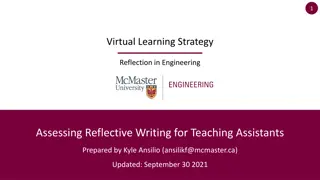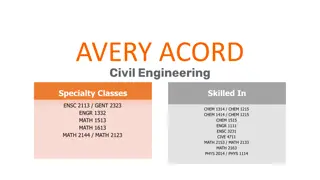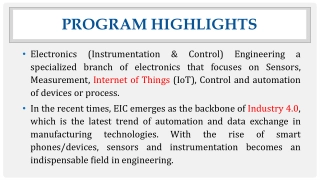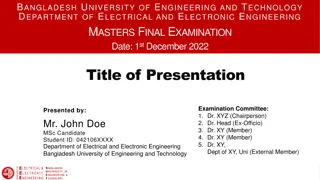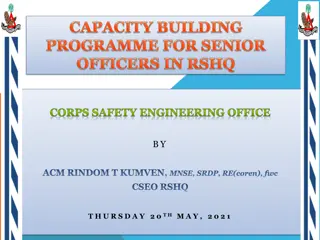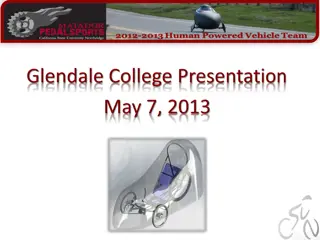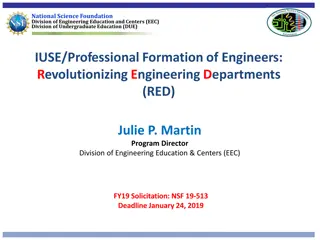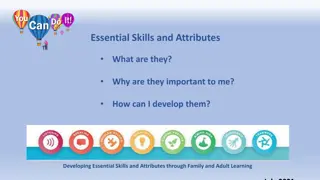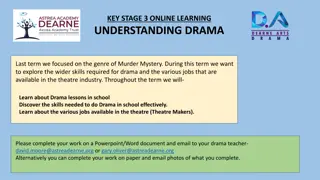Developing Effective Presentation Skills for Biomedical Engineering Students
Understanding the key components of an effective presentation is crucial for success. This includes considering the audience's needs, setting clear objectives, and preparing engaging content. By following the seven stages of planning a presentation, focusing on objectives, addressing the audience, and adapting to the venue, presenters can enhance their communication skills and achieve their goals effectively.
- Presentation Skills
- Biomedical Engineering
- Effective Communication
- Audience Engagement
- Planning Strategies
Download Presentation

Please find below an Image/Link to download the presentation.
The content on the website is provided AS IS for your information and personal use only. It may not be sold, licensed, or shared on other websites without obtaining consent from the author. Download presentation by click this link. If you encounter any issues during the download, it is possible that the publisher has removed the file from their server.
E N D
Presentation Transcript
AL-MUSTAQBAL UNIVERSITY Department of Biomedical Engineering MSC.REEM SALAH HASSAN PRESENTATION SKILLS PLANNING AN EFFECTIVE PRESENTATION
What is an effective presentation? An effective presentation makes the best use of the relationship between the presenter and the audience. It takes full consideration of the audience s needs in order to capture their interest, develop their understanding, inspire their confidence and achieve the presenter s objectives.
Seven stages in planning a presentation 1. Preparation Many factors affect the design of your presentation. A effective presenter will acknowledge and address each of the Following objectives audience venue remi
Objectives Why you are making your presentation? Bear in mind what you want to achieve and what you want your audience to take away with them. Once you have decided upon your objectives, you are in a much better position to make strategic decisions about the design and tone of your presentation. For example, a presentation to a seminar group might require a balanced argument, whereas a charity appeal might require a more creative approach. Ask yourself what do you want your audience to have understood? what action do you want your audience to take following your presentation? how can you best design your presentation to meet your objectives
Audience Your audience will have a variety of different experiences, interests and levels of knowledge. A effective presenter will need to acknowledge these and prepare for and respond to them accordingly. Ask yourself how much will your audience already know about your topic? how can you link new material to things they might already understand? will you need to win them over to a particular point of view?
You may not be able to answer these questions for each member of your audience but you should have enough information to ensure that you have targeted your material at the right level for their needs. This might involve avoiding technical jargon or explaining abstract concepts with clear practical examples. If you fail to consider your audience s needs, you will fail to appeal to their interest and imagination
Venue Where will you be making your presentation? What will the room be like? What atmosphere will the physical conditions create? A large lecture theatre might create a formal atmosphere. Similarly, a seminar room might create a less formal tone. Ask yourself: what kind of atmosphere do you wish to create? how might the room arrangement affect your relationship with the audience? can you do anything to change the arrangement of the room to suit your objectives? what audio-visual aids can you use?
Remit You may well have been given a remit for your presentation; you will need to stick to this. For example, you may have been asked to present a paper at a conference in a certain style or meet certain assessment criteria on your course. Ask yourself: how much time have you been allocated? are you required to stick to a common format or style? have any guidelines been set regarding the content of your presentation (i.e. a predetermined title, or a fixed number of overhead transparencies)?
2. Choosing your main points Once you have thought about the design of your presentation, you can define your main points. Try presenting no more than three main points in a ten minute presentation. Always allow time for an adequate introduction and conclusion. It is difficult for an audience to follow a more complex argument without significant help from the presenter. A effective presentation delivers information in a logical, structured manner, building on the previous point and avoiding large jumps in sequence. Ask yourself: what are the main points you wish to make? are these points structured in a logical, coherent way? do these main points reflect your own objectives and take account of the needs of your audience?
3. Choosing your supporting information your main points. This evidence might take the form of factual data, points of detail or an explanation of process. It might be presented in imaginative ways using diagrams, pictures or video segments. Think about: what will add clarity to your argument (explaining complex terms, reminding your audience of any supporting theories)? what will add authority to your argument (making connections with other people's work, quoting experts, offering evidence from your own research)? what will add colour to your argument (showing a video clip or a slide, using a practical example or a vibrant analogy)? The supporting information helps your audience understand, believe in and agree with
4. Establishing linking statements The next stage is to develop the linear flow of your presentation. This can be achieved by using linking statements to show clearly how your main points fit together. Common linking statements include: The next stage in our project was to ; Another important issue of consideration was ; By following this argument we can now see that . Linking statements send signals to your audience, highlighting the next point in your argument, linking to earlier ideas or clarifying the stage you have reached in your argument overall. This may be of particular importance in a lengthy presentation where even the most effective presenter has to work hard to keep an audience involved.
5. Developing an opening The introduction to your presentation is crucial. It is your first point of contact with your audience; you can either capture or lose your audience s interest in a matter of seconds. Use your introduction to lay a clear foundation for the presentation to follow. Try using the following structure: introduce yourself; state what you will be talking about (a title or subject area); state how you will be talking about it (e.g. by comparing test results or reviewing the supporting literature); state what you intend to be the outcome of your presentation (an informed group, a lively discussion); state what you expect your audience to do (listen, take notes, read a handout, ask questions before/during/after). Always give your audience a moment to absorb this information before moving into your first main poin
6. Developing a conclusion Your conclusion is another important stage in your presentation. You can use it to remind your audience of your main points, draw these points to a stimulating conclusion and leave your audience with a lasting impression of the quality of your presentation. The following structure provides a effective conclusion: a review of your title or subject area In this presentation I wanted to explore the relationship between X and Y. ; a summary of your main points We have discussed the following points ; a summary of the process you have been through By looking at X we have found that Y
a conclusion clearly drawn from your main points (this must be supported by the detail of your presentation) It is clear that there can be no substantive relationship between X and Y ; a parting statement to stimulate your audience s thoughts (this might be a question or a bold comment).
7. Reviewing your presentation Once you have written your presentation make sure that you review its content. Ask yourself does the presentation meet your objectives? is it logically structured? have you targeted the material at the right level for your audience? is the presentation too long or too short?
Where next? The next leaflet in this series, Delivering an effective presentation explores the process of speaking in public and discusses the need for lively interaction between the presenter and the audience


